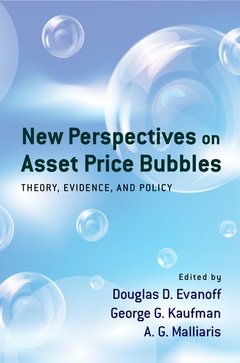Description
New Perspectives on Asset Price Bubbles
Coordinators: Evanoff Douglas D., Kaufman George G., Malliaris A. G.
Language: English
Subjects for New Perspectives on Asset Price Bubbles:
New perspectives on asset price bubbles (paperback)
Publication date: 03-2012
480 p. · 16.6x23.8 cm · Hardback
Publication date: 03-2012
480 p. · 16.6x23.8 cm · Hardback
New perspectives on asset price bubbles (hardback)
Publication date: 03-2012
480 p. · 15.8x24.1 cm · Hardback
Publication date: 03-2012
480 p. · 15.8x24.1 cm · Hardback
Description
/li>Contents
/li>Biography
/li>
This volume critically re-examines the profession's understanding of asset bubbles in light of the global financial crisis of 2007-09. It is well known that bubbles have occurred in the past, with the October 1929 crash as the most demonstrative example. However, the remarkably well-behaved performance of the US economy from 1945 to 2006, and, in particular during the Great Moderation period of 1984 to 2006, assured the economics profession and monetary policymakers that asset bubbles could be effectively managed with little or no real economic impact. The recent financial crisis has now triggered a debate about the emergence of a sequence of repeated bubbles in the Nasdaq market, housing market, credit market, and commodity markets. The realities of the crisis have intensified theoretical modeling, empirical methodologies, and debate on policy issues surrounding asset price bubbles and their potentially adverse economic impact if poorly managed. Taking a novel approach, the editors of this book present five classic papers that represent accepted thinking about asset bubbles prior to the financial crisis. They also include original papers challenging orthodox thinking and presenting new insights. A summary essay highlights the lessons learned and experiences gained since the crisis.
Introduction. 1. New Perspectives on Asset Price Bubbles: An Overview. Douglas D. Evanoff, George G. Kaufman and A.G. Malliaris. Bubbles: Theory and Evidence. 2. Churning Bubbles. Franklin Allen and Gary Gorton. Seminal research paper: The Review of Economic Studies, Volume 60 (1993).. 3. Rethinking Theoretical Models of Bubbles: Reflections Inspired by the Financial Crisis and the Allen and Gorton's Paper on Churning Bubbles. Gadi Barlevy. Consequences of Bubbles Bursting. 4. The Japanese Banking Crisis: Where Did it Come From and How Will it End? Takeo Hoshi and Anil K. Kashyap. Seminal research paper: NBER Macroeconomics Annual 1999, vol 14 (2000).. 5. The Impact of the International Financial Crisis on Asia and the Pacific: Highlighting Monetary Policy Challenges from an Asset Price Bubble Perspective. Andrew Filardo. Bubbles and Monetary Policy. 6. Monetary Policy and Asset Price Volatility. Ben Bernanke and Mark Gertler. Seminal research paper: Economic Review, Federal Reserve Bank of Kansas City (1999).. 7. Monetary Policy and Asset price Volatility: Should We Refill the Bernanke-Gertler Prescription?. Kenneth N. Kuttner. Bubbles and Macroprudential Regulation. 8. Towards a Macroprudential Framework for Financial Supervision and Regulation? Claudio Borio. Seminal research paper: CESifo Economic Studies, Volume 49 (2003).. 9. Bank Liquidity and Bubbles: Why Central Banks Should Lean Against Liquidity. Viral V. Acharya and Hassan Naqvi. Bubbles: Behavioral Explanations. 10. Overconfidence and Speculative Bubbles. Jose A. Scheinkman and Wei Xiong. Seminal research paper: Journal of Political Economy, Volume 111 (2003).. 11. Asset Bubbles: Insights from Behavioral Finance. Werner De Bondt. Bubbles: Keynote Presentations. 12. An Old Perspective on Asset Price Bubbles Policy. William Poole. 13. Struggling to Escape From 'Assumption 14'. Benjamin M. Friedman. New Ideas on Asset Price Bubbles. 14. Monetary Policy and Stock Market Booms. Lawrence J. Christiano, Cosmin Ilut, Roberto Motto, and Massimo Rostagno. 15. Leverage and Bubbles: The Need to Manage the Leverage Cycle. John Geanakoplos. Asset Bubbles, Central Banks and Investments. 16. Asset Price Bubbles and Central Bank Policies: The Crash of the Jackson Hole Consensus. A. G. Malliaris. 17. Do Bubbles Lead to Overinvestment? A Revealed Preference Approach. Robert Chirinko and Huntley Schaller.
Douglas D. Evanoff is a vice president and senior research advisor for banking issues at the Federal Reserve Bank of Chicago. His current research interests include asset bubbles, mortgage markets, and financial regulation. His research has been published in various journals and he has also edited a number of books addressing issues associated with financial institutions. George G. Kaufman is the John Smith Professor of Finance and Economics at Loyola University Chicago. His research and teaching interests focus on the management and regulation of financial institutions and markets. He previously taught at the University of Oregon and was a visiting professor at Stanford and the University of California at Berkeley. He is the editor of the Journal of Financial Stability and a coeditor of five other journals. He is the past president of the Western Finance Association. Anastasios G. Malliaris is currently Professor of Economics and Finance and holds the Walter F. Mullady Sr. Chair in Business Administration at Loyola University Chicago. He has authored and co-authored numerous articles in financial economics in several professional journals. He has had a long interest in asset price bubbles and financial instabilities.
© 2024 LAVOISIER S.A.S.




